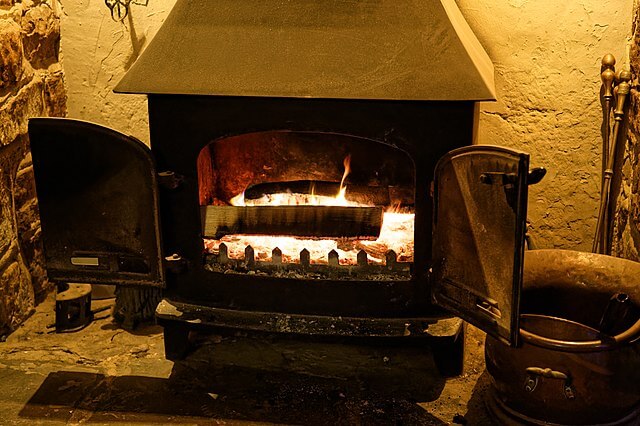
The rise in UK wood-burners creating “pollution hotspots” in wealthy areas.
One of the leading experts on air pollution in the UK has issued a warning that a significant increase in wood burning in urban areas may be bringing harmful pollution to a greater number of people and shifting the pattern of pollution from poorer to wealthier areas.
Currently, busy roads are the primary focus of air pollution monitoring because they have been the primary sources of fine particulate matter (PM2.5) and other air pollutants, primarily from diesel vehicles.
Gary Fuller, dean of the school of public health at Imperial College London, feared that as a result, researchers might miss the development of new hotspots caused by wood-burning stoves.
“There is certainly a concern that we are creating new air pollution hotspots, including in more affluent areas, where people do not think of their environment as being polluted,” Fuller said.
“As a first step people have to understand that the wood smoke that they smell could be harming their health. People perceive wood smoke to be harmless because it comes from a natural fuel. People need to understand that the wood smoke that fills their neighbourhood is as harmful as the air pollution from traffic or industry,” he said.
He mentioned a recent study in Islington, north London, in which backpack-carrying walkers were able to identify solid fuel pollution sources.
Numerous health issues, including dementia and mental illness in children as well as heart failure and lung issues, have been linked to PM2.5 pollution.
Fuller said: “My inbox is already full of people who are breathing wood smoke from their neighbours. These are typically people who care for someone else and are worried about the smoke filling the bedroom of their asthmatic child or elderly relative.”
To assess the air pollution caused by wood-burning stoves, Fuller has sent backpack-carrying researchers to a few London streets.
Although this kind of research is still in its infancy and there is still a great deal of work to be done, Fuller stated that static monitors at busy intersections and roads were missing signs of potential hotspots, likely caused by wood burning.
Fuller went on to say that wood-burners are also likely to be affecting a much larger number of people than conventional pollution patterns that focus on roads. This is due to the fact that most people use their boilers at night, when their neighbors are more likely to be home and thus exposed to the smoke.
This is in contrast to patterns of traffic pollution, which tend to peak during peak times of the day and decrease at night when people are more likely to be at home.
“People burn wood on cold winter nights when their neighbours are at home,” Fuller said. “Air pollution can settle over an area, meaning that more people can be exposed than those that experience traffic pollution from busy roads.”
According to a study conducted by Kantar for the Department for Environment, Food, and Rural Affairs, nearly half of wood-burning stoves are purchased by upper-AB social classes. Compared to households without indoor burners, of which about a quarter were from AB social grades and more than a third rented, about four out of ten households with indoor burners owned their home outright.
Fuller added that government policy has not yet fully taken into account the implications of these changes to pollution patterns and the potential for a much wider range of people to be exposed to pollution. Further research and monitoring were required.
Thérèse Coffey, the secretary of environment, made a statement last week that people should be “educated” about how to use wood-burning stoves rather than being subjected to “fingerpointing.” However, she did not mention any new measures to curb the use of existing stoves.
Under the 2021 Environment Act, she said, councils could use their existing authority to reduce air pollution sources, such as imposing fines in smoke control areas.
However, the Guardian was informed by local governments that they lacked the funds to carry out the additional monitoring and enforcement that would be required for a crackdown without receiving additional funding from the central government.
Wood-burning stoves, which have gained popularity in recent years partly for aesthetic reasons and sometimes in response to the high cost of fossil fuels, are responsible for an increasing amount of air pollution in urban areas.
Because trees can be grown again and absorb carbon from the air, many wood-burning stoves advertise themselves as environmentally friendly. However, environmentalists argue that large-scale wood burning actually hurts the environment because it takes trees up to a century to grow back and store the same amount of carbon as burned wood does.
Domestic wood-burning stoves should be phased out, according to the statutory adviser on greenhouse gas emissions, the Committee on Climate Change.
——————————————————————————
At Natural World Fund, we are passionate about stopping the decline in our wildlife.
The declines in our wildlife is shocking and frightening. Without much more support, many of the animals we know and love will continue in their declines towards extinction.
When you help to restore a patch of degraded land through rewilding to forests, meadows, or wetlands, you have a massive impact on the biodiversity at a local level. You give animals a home and food that they otherwise would not have had, and it has a positive snowball effect for the food chain.
We are convinced that this is much better for the UK than growing lots of fast-growing coniferous trees, solely to remove carbon, that don’t actually help our animals to thrive.
This is why we stand for restoring nature in the UK through responsible rewilding. For us, it is the right thing to do. Let’s do what’s right for nature!
Support our work today at https://naturalworldfund.com/ and join in the solution!

